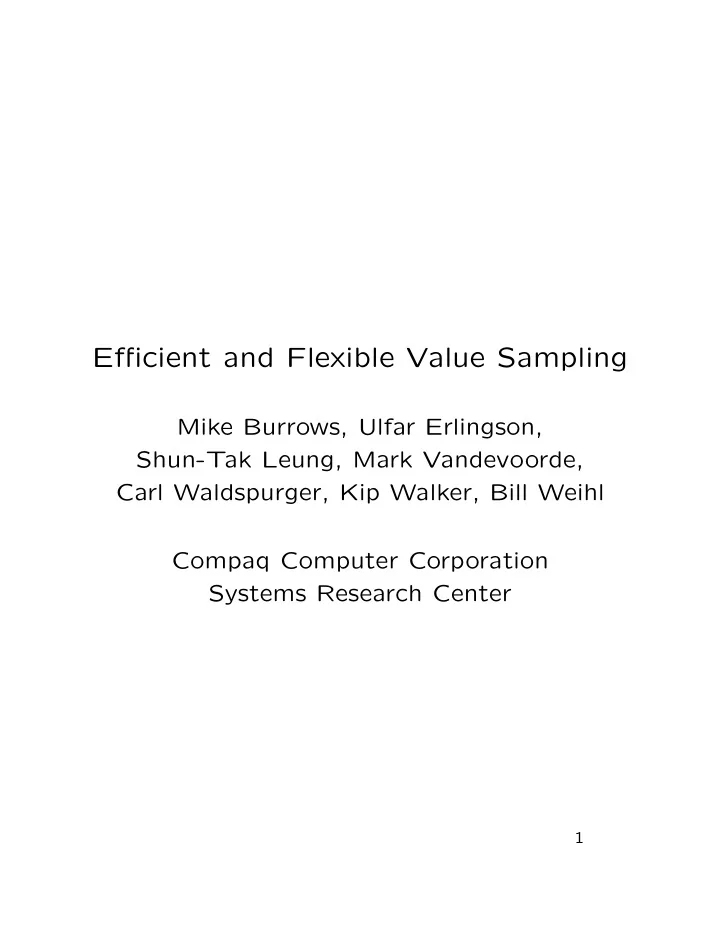

Efficient and Flexible Value Sampling Mike Burrows, Ulfar Erlingson, Shun-Tak Leung, Mark Vandevoorde, Carl Waldspurger, Kip Walker, Bill Weihl Compaq Computer Corporation Systems Research Center 1
Goal: Value profiling Record values during program execution. Find “semi-invariant” values for prefetching, specialization, speculation. For example: A load reads from 0x3c8 95% of the time. A function is always evaluated at zero. 2
Possible techniques Instrument program with a binary editor (Calder et al. , 97). Interpret, and record values generated. Sample values using periodic timer interrupts. We explored the last approach. It’s potentially far less intrusive. 3
DCPI review DCPI profiles all address spaces. Generates periodic interrupts. Interrupt routine records process ID and PC. User-space daemon maps to offset/executable, and aggregates samples in files. Tools report data for executables, procedures, and instructions. 4
Value sampling with DCPI On each interrupt, collect values. Somehow associate values with PC,PID. Summarize the values, and aggregate in files. Tools analyse summaries to find optimization opportunities. 5
Inherited properties of DCPI It’s a sampling technique. It has modest overhead. Low enough for production use. It’s transparent to the user. It can be used on the whole system. 6
Associating values with instructions Which instructions generated which values? On interrupt, we don’t know: which instruction was last executed. which register was last written. 7
First try—“bounce back” interrupt Alpha 21164 can interrupt after k user-mode cycles. On a periodic interrupt: record PC; set k to be small; return. On “bounce-back” interrupt, match executed instructions against register contents. 8
Bounce-back is tricky Works only on user-mode on the 21164. Hard to set k because timing is unpredictable. e.g. Chip interrupts 6 cycles after event. Occasionally confused by tight loops. — Evict the i-cache line to improve predictability. Start by setting k small, and increase. 9
Collecting values with an interpreter On each interrupt, interpret a few instructions. Save values associated with each instruction. 10
Should interpreter have side-effects? No side-effects ⇒ correctness less critical. But we want to value-profile the kernel, and loads have side-effects in device drivers. So interpreter must affect process state. Fortunately, testing is merely tedious. 11
Interpreter advantages It’s easy to associate values with instructions. We can gather other values, e.g. load latency, PC of calling procedure. User can configure what data to gather. We can interpret in user mode via an up-call. 12
Interpreter limitations Can’t interpret when interrupts are disabled. Can’t interpret through an OS trap. Can’t interpret for too long. 13
Hotlists: Gibbons & Matias’ algorithm One algorithm instance per PC. Counts each value seen with probability p . p is decreased so counts fit in constant space. Probabilistically yields most common values & frequency estimates. It’s a great simplification over ad hoc schemes. 14
A value profile cycles instruction 39 ldq ra, -16(t12) ra:(98.94% 0xff...ff) (0.53% ... 0 and a1, s1, v0 v0:(4.76% 0x55...00) (3.17% ... 0 and a1, s3, a1 a1:(100.00% 0x0) 0 eqv v0, s2, v0 v0:(4.23% 0x55...00) (2.65% ... 0 xor a1, s4, a1 a1:(100.00% 0x0) 9748 bic ra, v0, v0 v0:(100.00% 0x55...1c) 15
Load latencies Measured using CPU’s cycle counter. cycles instruction latencies 0.0 ldt $f17, 8(t6) (94.3% D) (3.6% M) (2.1% B) ... 0.0 ldt $f11, 0(t2) (84.9% M) (15.1% D) (0.0% B) ... 102.3 mult $f11,$f17,$f17 16
Are latency values meaningful? Usually, yes. We displace a few percent of d-cache lines. — Can’t get i-cache fill latencies with interpreter. Nor mispredict penalties. 17
21264 replay traps Reordering can violate memory semantics. e.g. a load of L reordered before a store of L A replay trap replays the offending instruction. Expensive: all later instructions are replayed. Hardware counters say where the trap occurred, but not why. 18
Identifying replay trap cause: vreplay Interpret > 100 instructions at a time. Interpreter compares load/store addresses. Records which instructions could conflict. Later, combine results and hardware counts. 19
vreplay output replays vcount ... 0 0x...2a0 stt $f8, 104(sp) 5 (100.0% 0x...4f8) 0 0x...2a4 bis a0, a0, s5 0 0 0x...2a8 bis a1, a1, s6 0 ... 0 0x...2c8 bis v0, v0, s2 0 43 0x...2cc ldq at, 0(a0) 25 (100.0% 0x...0d0) 0 0x...2d0 bsr ra, 0x20027a50 0 ... 20
Overhead CPU2000 integer benchmarks Average DCPI option Slowdown % no vprof 3.9 vprof 10.7 vreplay 5.9 vprof interprets 4 instructions per 124k vreplay interprets 128 instructions per 8M 21
Summary Periodic interpretation: flexible, about 10% overhead. Provides value profiles and data not provided by hardware counters. Gibbons and Matias’ algorithm is useful. — Download from http://www.tru64unix.compaq.com/dcpi/ 22
Related work Gabbay and Mendelson, 1996. Calder et al , 1997, 1999. Feller, 1998. Deaver et al , 1999. Bala et al , 1999. Chambers and Ungar, 1989. 23
Recommend
More recommend